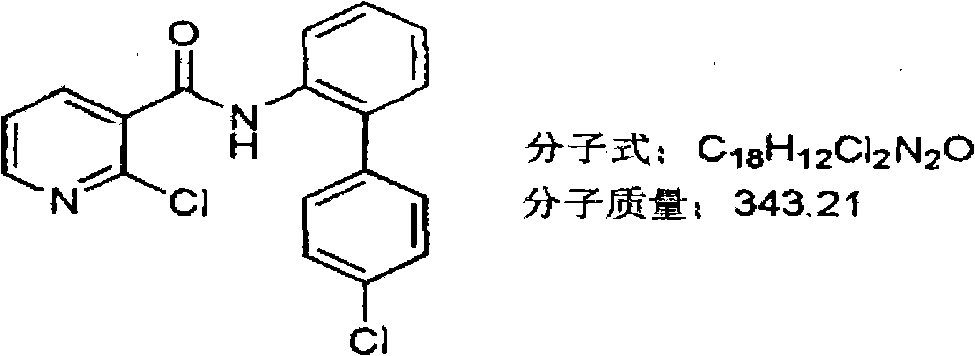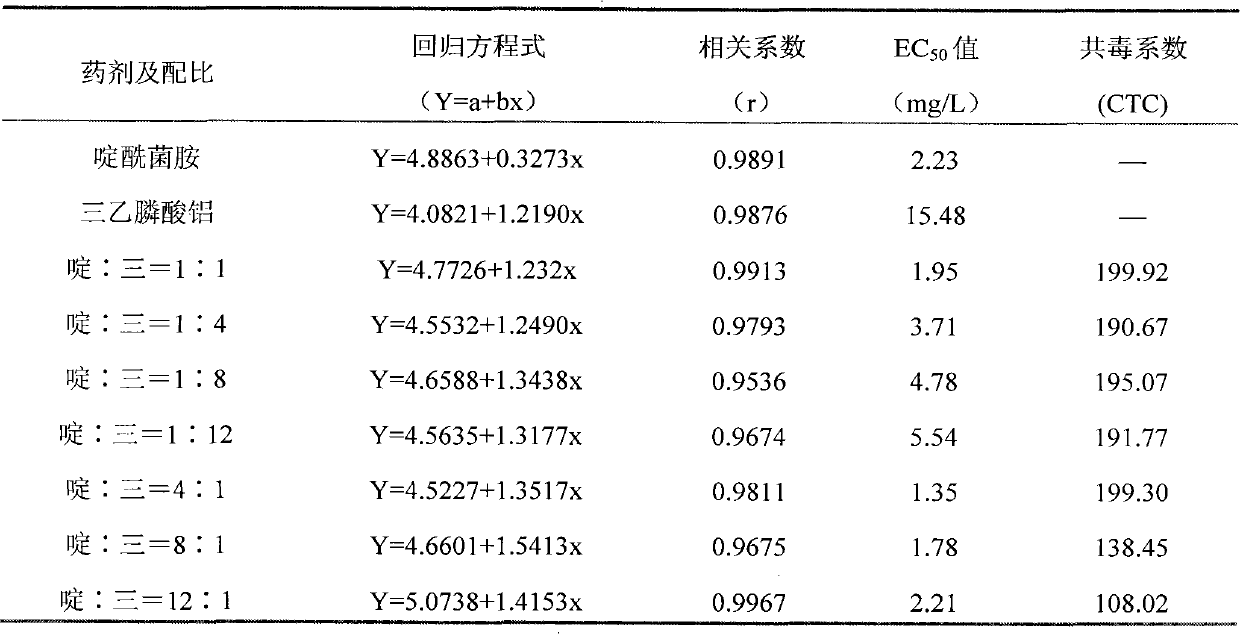Bactericidal composition containing boscalid and fosetyl-aluminium
A technology of aluminum triethylphosphonate and boscalid, applied in the directions of fungicides, biocides, biocides, etc., can solve the problems of increased use cost, increased resistance risk, increased application amount, etc. Service life, reducing the dosage and cost of pesticides, and reducing the effect of residues
- Summary
- Abstract
- Description
- Claims
- Application Information
AI Technical Summary
Problems solved by technology
Method used
Image
Examples
example 1
[0025] Physical Test Example 1: Determination of the Toxicity of Boscalid and Aluminum Triethylphosphonate to Rice Sheath Blight
[0026] 1. Test object: rice sheath blight fungus [Latin scientific name: Thanatephorus cucumeris (Frank) Donk.]
[0027] 2. Test method: refer to "Pesticide Bioassay Test Guidelines NY / T 1156.5-2006", and use the drug-containing medium method.
[0028] 3. Statistical analysis of data: SAS 6.12 statistical software was used for analysis. Calculate the mycelia growth inhibition rate (%) according to the test data, and obtain the virulence regression equation, correlation coefficient (r), EC 50 and co-toxicity coefficient.
[0029] 4. Evaluation method: Refer to the "Pesticide Bioassay Test Guidelines NY / T 1156.5-2006", and evaluate the synergistic effect of the drug mixture according to the co-toxicity coefficient method (CTC) of Sun & Johnson (1960), that is, CTC ≤ 80 is an antagonistic effect, 80<CTC<120 is an additive effect, and CTC≥120 is a s...
example 2
[0035] Physical Test Example 2: Determination of Toxicity of Boscalid and Aluminum Triethylphosphonate to Barley Leaf Rust
[0036] 1. Test object: barley leaf rust [Latin scientific name: Puccinia hordei Otth.]
[0037] 2. Test method: refer to the "Pesticide Bioassay Test Guidelines NY / T 1156.15-2008", and use the drug-containing medium method.
[0038] 3. Statistical analysis of data: use SAS6.12 statistical software for analysis. Calculate the mycelia growth inhibition rate (%) according to the test data, and obtain the virulence regression equation, correlation coefficient (r), EC 50 and co-toxicity coefficient.
[0039] 4. Evaluation method: Refer to the "Pesticide Bioassay Test Guidelines NY / T 1156.15-2008", according to Sun & Johnson (1960) co-toxicity coefficient method (CTC) to evaluate the synergistic effect of drug mixing, that is, CTC ≤ 80 is an antagonistic effect, 80
[0040] 5. Results and ...
example 3
[0045] Physical measurement example 3: Toxicity determination of the combination of boscalid and aluminum triethylphosphonate against rice cloud-shaped bacteria
[0046] 1. Test object: rice cloud-shaped bacteria [Latin scientific name: Gerlachia oryzae (Hashioka et Yokogi) w.Gams]
[0047] 2. Test method: refer to the "Pesticide Bioassay Test Guidelines NY / T 1156.2-2006", and use the drug-containing medium method.
[0048] 3. Statistical analysis of data: use SAS6.12 statistical software for analysis. Calculate the mycelia growth inhibition rate (%) according to the test data, and obtain the virulence regression equation, correlation coefficient (r), EC 50 and co-toxicity coefficient.
[0049] 4. Evaluation method: Refer to "Pesticide Bioassay Test Guidelines NY / T 1156.2-2006", according to Sun & Johnson (1960) co-toxicity coefficient method (CTC) to evaluate the synergistic effect of drug mixing, that is, CTC ≤ 80 is antagonism, 80<CTC<120 is an additive effect, and CTC≥1...
PUM
 Login to View More
Login to View More Abstract
Description
Claims
Application Information
 Login to View More
Login to View More - R&D
- Intellectual Property
- Life Sciences
- Materials
- Tech Scout
- Unparalleled Data Quality
- Higher Quality Content
- 60% Fewer Hallucinations
Browse by: Latest US Patents, China's latest patents, Technical Efficacy Thesaurus, Application Domain, Technology Topic, Popular Technical Reports.
© 2025 PatSnap. All rights reserved.Legal|Privacy policy|Modern Slavery Act Transparency Statement|Sitemap|About US| Contact US: help@patsnap.com



